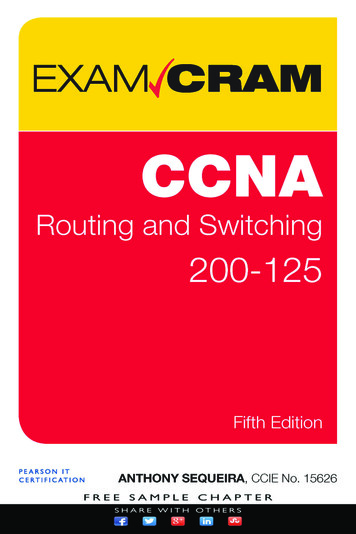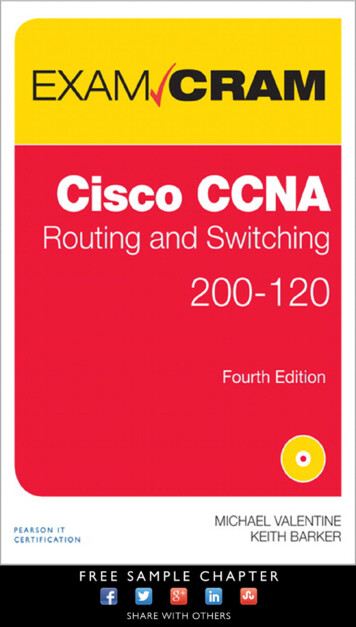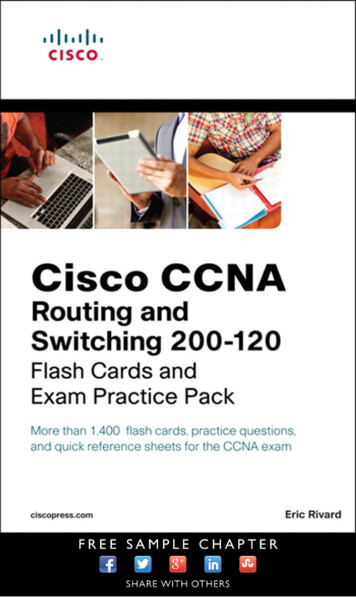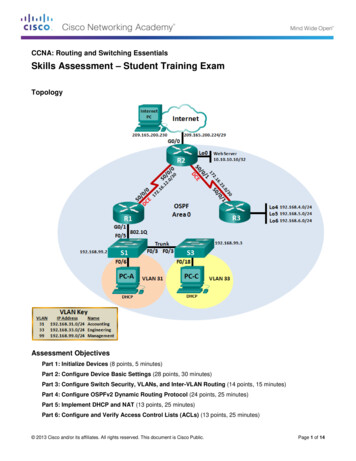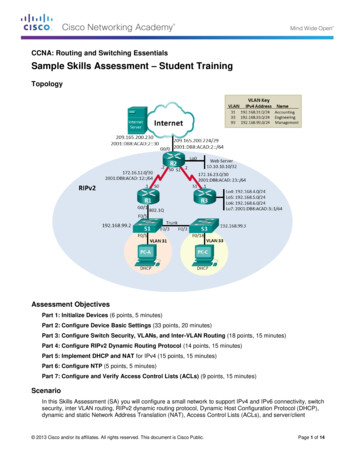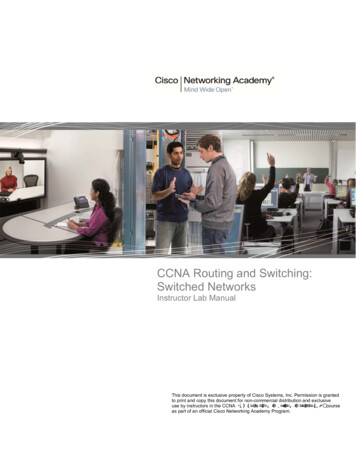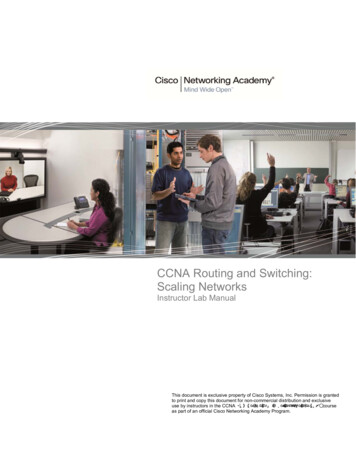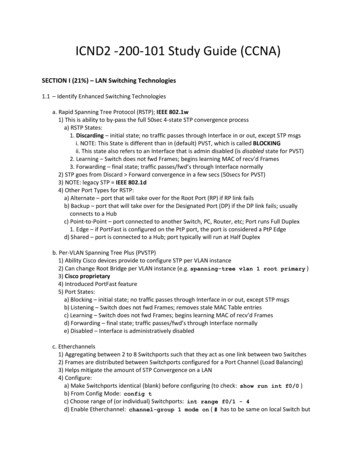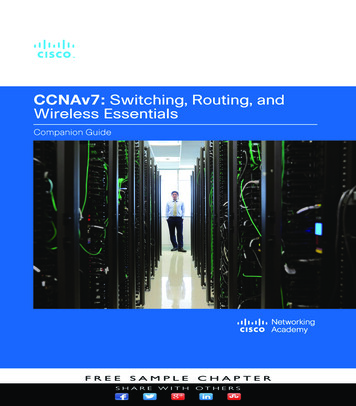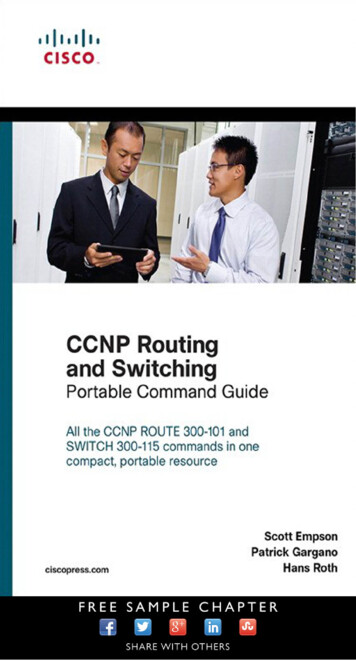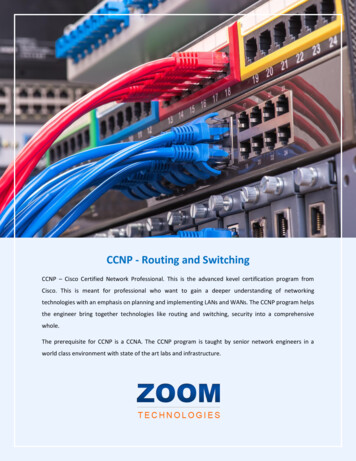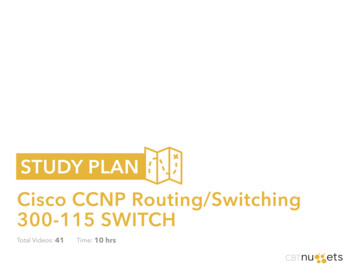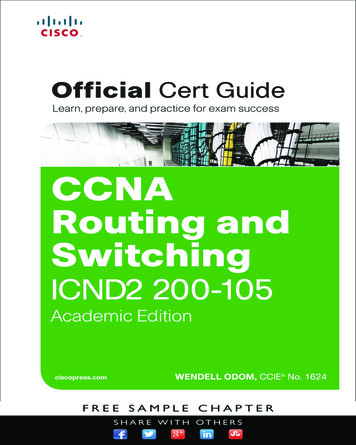
Transcription
CCNARouting andSwitchingICND2 200-105Official Cert GuideAcademic EditionWENDELL ODOM, CCIE No. 1624with contributing authorSCOTT HOGG, CCIE No. 5133Cisco Press800 East 96th StreetIndianapolis, IN 46240
iiCCNA Routing and Switching ICND2 200-105 Official Cert Guide, Academic EditionCCNA Routing and Switching ICND2200-105 Official Cert Guide Academic EditionWendell Odom with contributing author Scott HoggCopyright 2017 Pearson Education, Inc.Published by:Cisco Press800 East 96th StreetIndianapolis, IN 46240 USAAll rights reserved. No part of this book may be reproduced or transmitted in any form or by any means, electronic ormechanical, including photocopying, recording, or by any information storage and retrieval system, without written permission from the publisher, except for the inclusion of brief quotations in a review.Printed in the United States of AmericaFirst Printing August 2016Library of Congress Control Number: 2016936746ISBN-13: 978-1-58720-598-9ISBN-10: 1-58720-598-XWarning and DisclaimerThis book is designed to provide information about the Cisco ICND2 200-105 exam for CCNA Routing and Switchingcertification. Every effort has been made to make this book as complete and as accurate as possible, but no warranty orfitness is implied.The information is provided on an “as is” basis. The authors, Cisco Press, and Cisco Systems, Inc. shall have neitherliability nor responsibility to any person or entity with respect to any loss or damages arising from the information contained in this book or from the use of the discs or programs that may accompany it.The opinions expressed in this book belong to the author and are not necessarily those of CiscoSystems, Inc.Trademark AcknowledgmentsAll terms mentioned in this book that are known to be trademarks or service marks have been appropriately capitalized.Cisco Press or Cisco Systems, Inc., cannot attest to the accuracy of this information. Use of a term in this book shouldnot be regarded as affecting the validity of any trademark or service mark.
iiiSpecial SalesFor information about buying this title in bulk quantities, or for special sales opportunities (which may include electronicversions; custom cover designs; and content particular to your business, training goals, marketing focus, or brandinginterests), please contact our corporate sales department at corpsales@pearsoned.com or (800) 382-3419.For government sales inquiries, please contact governmentsales@pearsoned.com.For questions about sales outside the U.S., please contact intlcs@pearson.com.Feedback InformationAt Cisco Press, our goal is to create in-depth technical books of the highest quality and value. Each book is crafted withcare and precision, undergoing rigorous development that involves the unique expertise of members from the professional technical community.Readers’ feedback is a natural continuation of this process. If you have any comments regarding how we could improvethe quality of this book, or otherwise alter it to better suit your needs, you can contact us through email atfeedback@ciscopress.com. Please make sure to include the book title and ISBN in your message.We greatly appreciate your assistance.Editor-in-Chief: Mark TaubCopy Editor: Bill McManusProduct Line Manager: Brett BartowTechnical Editor(s): Aubrey Adams, Elan BeerBusiness Operation Manager, Cisco Press: Jan CornelssenEditorial Assistant: Vanessa EvansManaging Editor: Sandra SchroederCover Designer: Chuti PrasertsithDevelopment Editor: Drew CuppComposition: Bronkella PublishingSenior Project Editor: Tonya SimpsonIndexer: Publishing Works, Inc.Proofreader: Paula Lowell
ivCCNA Routing and Switching ICND2 200-105 Official Cert Guide, Academic EditionAbout the AuthorWendell Odom, CCIE No. 1624 (Emeritus), has been in the networking industry since 1981. He hasworked as a network engineer, consultant, systems engineer, instructor, and course developer; he currently works writing and creating certification study tools. This book is his 27th edition of some product for Pearson, and he is the author of all editions of the CCNA Routing and Switching and CCENTCert Guides from Cisco Press. He has written books about topics from networking basics, and certification guides throughout the years for CCENT, CCNA R&S, CCNA DC, CCNP ROUTE, CCNPQoS, and CCIE R&S. He helped develop the popular Pearson Network Simulator. He maintainsstudy tools, links to his blogs, and other resources at http://www.certskills.com.About the Contributing AuthorScott Hogg, CCIE No. 5133, CISSP No. 4610, is the CTO for Global Technology Resources, Inc.(GTRI). Scott authored the Cisco Press book IPv6 Security. Scott is a Cisco Champion, foundingmember of the Rocky Mountain IPv6 Task Force (RMv6TF), and a member of the Infoblox IPv6Center of Excellence (COE). Scott is a frequent presenter and writer on topics including IPv6, SDN,Cloud, and Security.
vAbout the Technical ReviewersAubrey Adams is a Cisco Networking Academy instructor in Perth, Western Australia. With a background in telecommunications design, Aubrey has qualifications in electronic engineering and management; graduate diplomas in computing and education; and associated industry certifications. Hehas taught across a broad range of both related vocational and education training areas and universitycourses. Since 2007, Aubrey has technically reviewed a number of Pearson Education and Cisco Presspublications, including video, simulation, and online products.Elan Beer, CCIE No. 1837, is a senior consultant and Cisco instructor specializing in data centerarchitecture and multiprotocol network design. For the past 27 years, Elan has designed networks andtrained thousands of industry experts in data center architecture, routing, and switching. Elan has beeninstrumental in large-scale professional service efforts designing and troubleshooting internetworks,performing data center and network audits, and assisting clients with their short- and long-term designobjectives. Elan has a global perspective of network architectures via his international clientele. Elanhas used his expertise to design and troubleshoot data centers and internetworks in Malaysia, NorthAmerica, Europe, Australia, Africa, China, and the Middle East. Most recently, Elan has been focusedon data center design, configuration, and troubleshooting as well as service provider technologies. In1993, Elan was among the first to obtain the Cisco Certified System Instructor (CCSI) certification,and in 1996, he was among the first to attain Cisco System’s highest technical certification, the CiscoCertified Internetworking Expert. Since then, Elan has been involved in numerous large-scale datacenter and telecommunications networking projects worldwide.
viCCNA Routing and Switching ICND2 200-105 Official Cert Guide, Academic EditionDedicationsFor Kris Odom, my wonderful wife: The best part of everything we do together in life. Love you, doll.
viiAcknowledgmentsBrett Bartow again served as associate publisher and executive editor on the book. We’ve workedtogether on probably 20 titles now. Besides the usual wisdom and good decision making to guide theproject, he was the driving force behind adding all the new apps to the DVD/web. As always, Brett hasbeen a pleasure to work with, and an important part of deciding what the entire Official Cert Guideseries direction should be.As part of writing these books, we work in concert with Cisco. A special thanks goes out to variouspeople on the Cisco team who work with Pearson to create Cisco Press books. In particular, GregCote, Joe Stralo, and Phil Vancil were a great help while we worked on these titles.Drew Cupp did his usual wonderful job with this book as development editor. He took over the job forthis book during a pretty high-stress and high-load timeframe, and delivered with excellence. ThanksDrew for jumping in and getting into the minutia while keeping the big-picture features on track. Andthanks for the work on the online/DVD elements as well!Aubrey Adams and Elan Beer both did a great job as technical editors for this book, just as they did forthe ICND1 100-105 Cert Guide. This book presented a little more of a challenge, from the breadth ofsome of the new topics, just keeping focus with such a long pair of books in a short time frame. Manythanks to Aubrey and Elan, for the timely input, for taking the time to read and think about every newpart of the book, for finding those small technical areas, and for telling me where I need to do more.Truly, it’s a much better book because of the two of you.Hank Preston of Cisco Systems, IT as a Service Architect, and co-author of the Cisco Press CCNACloud CLDADM 210-455 Cert Guide, gave me some valuable assistance when researching before writing the cloud computing chapter (27). Hank helped me refine my understanding based on his greatexperience with helping Cisco customers implement cloud computing. Hank did not write the chapter,but his insights definitely made the chapter much better and more realistic.Welcome and thanks to Lisa Matthews for her work on the DVD and online tools, like the KeyTopics reviews. That work included many new math-related apps in the ICND1 book, but also manynew features that sit on the DVD and on this book’s website as review tools. Thanks for the hardwork, Lisa!I love the magic wand that is production. Presto, Word docs with gobs of queries and comments feedinto the machine, and out pops these beautiful books. Thanks to Sandra Schroeder, Tonya Simpson,and all the production team for making the magic happen. From fixing all my grammar, crummy wordchoices, and passive-voice sentences to pulling the design and layout together, they do it all; thanks forputting it all together and making it look easy. And Tonya, once again getting the “opportunity” tomanage two books with many elements at the same timeline. Once again, the juggling act continues,and once again, it is done well and beautifully. Thanks for managing the whole production processagain.The figures in the book continue to be an important part of the book, by design, with a great deal ofattention paid to choosing how to use figures to communicate ideas. Mike Tanamachi, illustrator andmind reader, did his usual great job creating the finished figure files once again. Thanks for the usualfine work, Mike!I could not have made the timeline for this book without Chris Burns of Certskills Professional. Chrisowns the mind map process now, owns big parts of the lab development process for the associated labsadded to my blogs, does various tasks related to specific chapters, and then catches anything I need totoss over my shoulder so I can focus on the books. Chris, you are the man!
viiiCCNA Routing and Switching ICND2 200-105 Official Cert Guide, Academic EditionSean Wilkins played the largest role he’s played so far with one of my books. A long-timeco-collaborator with Pearson’s CCNA Simulator, Sean did a lot of technology work behind the scenes.No way the books are out on time without Sean’s efforts; thanks for the great job, Sean!A special thanks to you readers who submit suggestions and point out possible errors, and especially tothose of you who post online at the Cisco Learning Network. Without question, past comments I havereceived directly and “overheard” by participating at CLN have made this edition a better book.Thanks to my wonderful wife, Kris, who helps make this sometimes challenging work lifestyle abreeze. I love walking this journey with you, doll. Thanks to my daughter Hannah. And thanks to JesusChrist, Lord of everything in my life.
ixContents at a GlanceIntroductionxxxiiiYour Study Plan 2Part IEthernet LANsChapter 1Implementing Ethernet Virtual LANsChapter 2Spanning Tree Protocol ConceptsChapter 3Spanning Tree Protocol ImplementationChapter 4LAN TroubleshootingChapter 5VLAN Trunking ProtocolChapter 6Miscellaneous LAN TopicsPart I Review156Part IIIPv4 Routing ProtocolsChapter 7Understanding OSPF ConceptsChapter 8Implementing OSPF for IPv4Chapter 9Understanding EIGRP ConceptsChapter 10Implementing EIGRP for IPv4Chapter 11Troubleshooting IPv4 Routing ProtocolsChapter 12Implementing External BGPPart II Review11123892114136161162184214234260286310Part IIIWide-Area NetworksChapter 13Implementing Point-to-Point WANsChapter 14Private WANs with Ethernet and MPLSChapter 15Private WANs with Internet VPNPart III Review64313314346368412Part IVIPv4 Services: ACLs and QoSChapter 16Basic IPv4 Access Control ListsChapter 17Advanced IPv4 Access Control ListsChapter 18Quality of Service (QoS)Part IV Review490464416436415
xCCNA Routing and Switching ICND2 200-105 Official Cert Guide, Academic EditionPart VIPv4 Routing and TroubleshootingChapter 19IPv4 Routing in the LANChapter 20Implementing HSRP for First-Hop RoutingChapter 21Troubleshooting IPv4 RoutingPart V Review493494516536556Part VIIPv6Chapter 22IPv6 Routing Operation and TroubleshootingChapter 23Implementing OSPF for IPv6Chapter 24Implementing EIGRP for IPv6Chapter 25IPv6 Access Control ListsPart VI Review561562584612632656Part VIIMiscellaneous 659Chapter 26Network ManagementChapter 27Cloud ComputingChapter 28SDN and Network ProgrammabilityPart VII Review660696724744Part VIIIFinal PrepChapter 29Final ReviewPart IXAppendixes 763Appendix ANumeric Reference TablesAppendix BCCNA ICND2 200-105 Exam UpdatesGlossaryIndex747748764770780816DVD AppendixesAppendix CAnswers to the Review QuestionsAppendix DPractice for Chapter 16: Basic IPv4 Access Control ListsAppendix EMind Map SolutionsAppendix FStudy PlannerAppendix GLearning IPv4 Routes with RIPv2Appendix HUnderstanding Frame Relay ConceptsAppendix IImplementing Frame RelayAppendix JIPv4 Troubleshooting ToolsAppendix KTopics from Previous EditionsAppendix LExam Topic Cross Reference
xiContentsIntroductionxxxiiiYour Study Plan2A Brief Perspective on Cisco Certification ExamsFive Study Plan Steps23Step 1: Think in Terms of Parts and Chapters3Step 2: Build Your Study Habits Around the ChapterStep 3: Use Book Parts for Major Milestones44Step 4: Use the Final Review Chapter to Refine Skills and Uncover WeaknessesStep 5: Set Goals and Track Your Progress6Things to Do Before Starting the First Chapter7Find Review Activities on the Web and DVD7Should I Plan to Use the Two-Exam Path or One-Exam Path?Study Options for Those Taking the 200-125 CCNA ExamOther Small Tasks Before Getting StartedGetting Started: Now99Part IEthernet LANs 11Chapter 1Implementing Ethernet Virtual LANsFoundation Topics781213Virtual LAN Concepts13Creating Multiswitch VLANs Using TrunkingVLAN Tagging Concepts1415The 802.1Q and ISL VLAN Trunking ProtocolsForwarding Data Between VLANs1616Routing Packets Between VLANs with a RouterRouting Packets with a Layer 3 Switch1719VLAN and VLAN Trunking Configuration and Verification19Creating VLANs and Assigning Access VLANs to an InterfaceVLAN Configuration Example 1: Full VLAN Configuration2020VLAN Configuration Example 2: Shorter VLAN ConfigurationVLAN Trunking Protocol24VLAN Trunking Configuration24Implementing Interfaces Connected to PhonesData and Voice VLAN Concepts2829Data and Voice VLAN Configuration and VerificationSummary: IP Telephony Ports on SwitchesChapter Summary33Review Questions 33Chapter Review343230235
xiiCCNA Routing and Switching ICND2 200-105 Official Cert Guide, Academic EditionChapter 2Spanning Tree Protocol ConceptsFoundation Topics3839Spanning Tree Protocol (IEEE 802.1D)The Need for Spanning Tree3939What IEEE 802.1D Spanning Tree DoesHow Spanning Tree Works4142The STP Bridge ID and Hello BPDUElecting the Root Switch4344Choosing Each Switch’s Root Port45Choosing the Designated Port on Each LAN SegmentInfluencing and Changing the STP Topology4748Making Configuration Changes to Influence the STP TopologyReacting to State Changes That Affect the STP TopologyHow Switches React to Changes with STPChanging Interface States with STPRapid STP (IEEE 802.1w) ConceptsComparing STP and RSTP5152RSTP and the Alternate (Root) Port RoleRSTP States and Processes5354RSTP and the Backup (Designated) Port RoleRSTP Port TypesPortFast565757BPDU Guard58Chapter Summary59Review Questions60Chapter ReviewChapter 35556Optional STP FeaturesEtherChannel495061Spanning Tree Protocol ImplementationFoundation Topics65Implementing STP65Setting the STP Mode6465Connecting STP Concepts to STP Configuration OptionsPer-VLAN Configuration Settings66The Bridge ID and System ID ExtensionPer-VLAN Port CostsSTP Configuration Option SummaryVerifying STP Operation67686868Configuring STP Port Costs71Configuring Priority to Influence the Root ElectionImplementing Optional STP Features74Configuring PortFast and BPDU Guard7472664948
xiiiConfiguring EtherChannel76Configuring a Manual EtherChannel77Configuring Dynamic EtherChannels79Implementing RSTP80Identifying the STP Mode on a Catalyst SwitchRSTP Port Roles83RSTP Port States84RSTP Port Types84Chapter Summary86Review Questions86Chapter ReviewChapter 48088LAN TroubleshootingFoundation Topics9293Troubleshooting STP93Determining the Root Switch93Determining the Root Port on Nonroot Switches94STP Tiebreakers When Choosing the Root Port95Suggestions for Attacking Root Port Problems on the ExamDetermining the Designated Port on Each LAN Segment9696Suggestions for Attacking Designated Port Problems on the ExamSTP Convergence98Troubleshooting Layer 2 EtherChannel98Incorrect Options on the channel-group Command98Configuration Checks Before Adding Interfaces to EtherChannelsAnalyzing the Switch Data Plane ForwardingPredicting STP Impact on MAC Tables101102Predicting EtherChannel Impact on MAC TablesChoosing the VLAN of Incoming Frames104Troubleshooting VLANs and VLAN Trunks105Access VLAN Configuration Incorrect105Access VLANs Undefined or Disabled106Mismatched Trunking Operational StatesMismatched Native VLAN on a TrunkChapter ReviewChapter 5103107Mismatched Supported VLAN List on TrunksChapter Summary108110111111VLAN Trunking ProtocolFoundation Topics97114115VLAN Trunking Protocol (VTP) ConceptsBasic VTP Operation115115Synchronizing the VTP Database116Requirements for VTP to Work Between Two Switches118100
xivCCNA Routing and Switching ICND2 200-105 Official Cert Guide, Academic EditionVTP Version 1 Versus Version 2VTP Pruning119119Summary of VTP Features120VTP Configuration and Verification121Using VTP: Configuring Servers and Clients121Verifying Switches Synchronized Databases123Storing the VTP and Related Configuration125Avoiding Using VTPVTP Troubleshooting126127Determining Why VTP Is Not Synchronizing127Common Rejections When Configuring VTP128Problems When Adding Switches to a NetworkChapter Summary131Review QuestionsChapter ReviewChapter 6131132Miscellaneous LAN TopicsFoundation Topics136137Securing Access with IEEE 802.1xAAA Authentication137139AAA Login Process139TACACS and RADIUS ProtocolsAAA Configuration ExamplesDHCP Snooping128139140142DHCP Snooping Basics142An Example DHCP-based AttackHow DHCP Snooping Works143144Summarizing DHCP Snooping FeaturesSwitch Stacking and Chassis Aggregation145146Traditional Access Switching Without StackingSwitch Stacking of Access Layer Switches146146Switch Stack Operation as a Single Logical SwitchCisco FlexStack and FlexStack-PlusChassis Aggregation148149149High Availability with a Distribution/Core Switch149Improving Design and Availability with Chassis AggregationChapter Summary152Review Questions152Chapter ReviewPart I Review156153150
xvPart IIIPv4 Routing Protocols 161Chapter 7Understanding OSPF ConceptsFoundation Topics162163Comparing Dynamic Routing Protocol FeaturesRouting Protocol Functions163Interior and Exterior Routing ProtocolsComparing IGPs164165IGP Routing Protocol AlgorithmsMetrics163165166Other IGP ComparisonsAdministrative Distance167167OSPF Concepts and OperationOSPF Overview168169Topology Information and LSAs169Applying Dijkstra SPF Math to Find the Best RoutesBecoming OSPF Neighbors170The Basics of OSPF Neighbors170Meeting Neighbors and Learning Their Router IDExchanging the LSDB Between Neighbors172Fully Exchanging LSAs with Neighbors173Maintaining Neighbors and the LSDB174Using Designated Routers on Ethernet LinksCalculating the Best Routes with SPFOSPF Area DesignOSPF Areas177178OSPF Area Design AdvantagesChapter 8179180181Review QuestionsChapter Review174176How Areas Reduce SPF Calculation TimeChapter Summary182183Implementing OSPF for IPv4Foundation Topics184185Implementing Single-Area OSPFv2185OSPF Single-Area Configuration186Matching with the OSPF network CommandVerifying OSPFv2 Single Area188Configuring the OSPF Router IDOSPF Passive InterfacesMultiarea Configuration191192Implementing Multiarea OSPFv2Single-Area Configurations170194195196187171
xviCCNA Routing and Switching ICND2 200-105 Official Cert Guide, Academic EditionVerifying the Multiarea Configuration197Verifying the Correct Areas on Each Interface on an ABRVerifying Which Router Is DR and BDRVerifying Interarea OSPF RoutesAdditional OSPF Features198199200OSPF Default Routes200OSPF Metrics (Cost)202Setting the Cost Based on Interface BandwidthThe Need for a Higher Reference BandwidthOSPF Load Balancing205OSPFv2 Interface Configuration Example205Verifying OSPFv2 Interface Configuration208Review Questions208Chapter ReviewChapter 9204204OSPFv2 Interface ConfigurationChapter Summary202206210Understanding EIGRP ConceptsFoundation Topics214215EIGRP and Distance Vector Routing ProtocolsIntroduction to EIGRP215215Basic Distance Vector Routing Protocol FeaturesThe Concept of a Distance and a Vector216Full Update Messages and Split Horizon217216Route Poisoning 219EIGRP as an Advanced DV Protocol220EIGRP Sends Partial Update Messages, As Needed220EIGRP Maintains Neighbor Status Using Hello221Summary of Interior Routing Protocol Features221EIGRP Concepts and OperationEIGRP Neighbors222222Exchanging EIGRP Topology Information223Calculating the Best Routes for the Routing TableThe EIGRP Metric Calculation224An Example of Calculated EIGRP MetricsCaveats with Bandwidth on Serial LinksEIGRP Convergence226227Feasible Distance and Reported DistanceEIGRP Successors and Feasible SuccessorsThe Query and Reply ProcessChapter Summary231Review Questions231Chapter Review233225229227228224198
xviiChapter 10 Implementing EIGRP for IPv4Foundation Topics234235Core EIGRP Configuration and VerificationEIGRP Configuration235235Configuring EIGRP Using a Wildcard MaskVerifying EIGRP Core Features236237Finding the Interfaces on Which EIGRP Is EnabledDisplaying EIGRP Neighbor Status240Displaying the IPv4 Routing Table241EIGRP Metrics, Successors, and Feasible SuccessorsViewing the EIGRP Topology TableFinding Successor Routes238242243244Finding Feasible Successor Routes245Convergence Using the Feasible Successor RouteExamining the Metric Components247248Other EIGRP Configuration Settings249Load Balancing Across Multiple EIGRP RoutesTuning the EIGRP Metric Calculation249251Autosummarization and Discontiguous Classful Networks252Automatic Summarization at the Boundary of a Classful NetworkDiscontiguous Classful NetworksChapter Summary253255Review Questions 255Chapter Review257Chapter 11 Troubleshooting IPv4 Routing ProtocolsFoundation Topics260261Perspectives on Troubleshooting Routing Protocol ProblemsInterfaces Enabled with a Routing ProtocolEIGRP Interface Troubleshooting262263Examining Working EIGRP Interfaces264Examining the Problems with EIGRP InterfacesOSPF Interface TroubleshootingNeighbor Relationships266268270EIGRP Neighbor Verification Checks272EIGRP Neighbor Troubleshooting ExampleOSPF Neighbor TroubleshootingFinding Area Mismatches273274276Finding Duplicate OSPF Router IDs277Finding OSPF Hello and Dead Timer MismatchesOther OSPF Issues280Shutting Down the OSPF ProcessMismatched MTU Settings281280279261252
xviiiCCNA Routing and Switching ICND2 200-105 Official Cert Guide, Academic EditionChapter SummaryChapter Review283283Chapter 12 Implementing External BGPFoundation TopicsBGP Concepts286287287Advertising Routes with BGPInternal and External BGP287288Choosing the Best Routes with BGPeBGP and the Internet Edge289290Internet Edge Designs and Terminology290Advertising the Enterprise Public Prefix into the InternetLearning Default Routes from the ISPeBGP Configuration and VerificationBGP Configuration Concepts293294Configuring eBGP Neighbors Using Link AddressesVerifying eBGP Neighbors294296Administratively Disabling Neighbors297Injecting BGP Table Entries with the network CommandInjecting Routes for a Classful NetworkAdvertising Subnets to the ISPLearning a Default Route from the ISP305Review Questions305Chapter ReviewPart II ReviewPart III298303306310Wide-Area Networks 313Chapter 13 Implementing Point-to-Point WANsFoundation Topics314315Leased-Line WANs with HDLCLayer 1 Leased Lines315315The Physical Components of a Leased LineThe Role of the CSU/DSU318Building a WAN Link in a Lab319Layer 2 Leased Lines with HDLC319Configuring HDLC320Leased-Line WANs with PPPPPP ConceptsPPP Framing323323324PPP Control ProtocolsPPP Authentication324325298300Advertising a Single Prefix with a Static Discard RouteChapter Summary291292316301
xixImplementing PPP326Implementing PPP CHAPImplementing PPP PAP327328Implementing Multilink PPPMultilink PPP ConceptsConfiguring MLPPPVerifying MLPPP330331332333Troubleshooting Serial Links335Troubleshooting Layer 1 Problems335Troubleshooting Layer 2 Problems336Keepalive Failure336PAP and CHAP Authentication FailureTroubleshooting Layer 3 ProblemsChapter Summary340Review Questions340Chapter Review337338342Chapter 14 Private WANs with Ethernet and MPLSFoundation TopicsMetro Ethernet346347347Metro Ethernet Physical Design and TopologyEthernet WAN Services and Topologies349Ethernet Line Service (Point-to-Point)Ethernet LAN Service (Full Mesh)347349350Ethernet Tree Service (Hub and Spoke)351Layer 3 Design Using Metro Ethernet351Layer 3 Design with E-Line Service352Layer 3 Design with E-LAN Service353Layer 3 Design with E-Tree Service353Ethernet Virtual Circuit Bandwidth Profiles354Charging for the Data (Bandwidth) Used355Controlling Overages with Policing and ShapingMultiprotocol Label Switching (MPLS)356MPLS VPN Physical Design and TopologyMPLS and Quality of ServiceLayer 3 with MPLS VPN359360OSPF Area Design with MPLS VPN361Routing Protocol Challenges with EIGRPChapter Summary364Review Questions 364Chapter Review365358362355
xxCCNA Routing and Switching ICND2 200-105 Official Cert Guide, Academic EditionChapter 15 Private WANs with Internet VPNFoundation Topics368369Internet Access and Internet VPN FundamentalsInternet Access369369Digital Subscriber LineCable Internet370371Wireless WAN (3G, 4G, LTE)Fiber Internet Access371372Internet VPN Fundamentals373Site-to-Site VPNs with IPsecClient VPNs with SSL375GRE Tunnels and DMVPN376GRE Tunnel Concepts374376Routing over GRE Tunnels376GRE Tunnels over the Unsecured NetworkConfiguring GRE TunnelsVerifying a GRE Tunnel380382Troubleshooting GRE Tunnels384Tunnel Interfaces and Interface State384Layer 3 Issues for Tunnel InterfacesIssues with ACLs and Security386387Multipoint Internet VPNs Using DMVPNPPP over EthernetPPPoE Concepts378388390391PPPoE Configuration392PPPoE Configuration Breakdown: Dialers and Layer 1PPPoE Configuration Breakdown: PPP and Layer 2PPPoE Configuration Breakdown: Layer 3PPPoE Configuration Summary394394A Brief Aside About Lab Experimentation with PPPoEPPPoE Verification393393395396Verifying Dialer and Virtual-Access Interface BindingsVerifying Virtual-Access Interface ConfigurationVerifying PPPoE Session Status399Verifying Dialer Interface Layer 3 StatusPPPoE Troubleshooting398400401Step 0: Status Before Beginning the First StepStep 1: Status After Layer 1 Configuration401402Step 2: Status After Layer 2 (PPP) ConfigurationStep 3: Status After Layer 3 (IP) ConfigurationPPPoE Troubleshooting Summary405403404397
xxiChapter Summary406Review Questions407Chapter Review408Part III Review 412Part IVIPv4 Services: ACLs and QoS415Chapter 16 Basic IPv4 Access Control ListsFoundation Topics416417IPv4 Access Control List Basics417ACL Location and Direction417Matching Packets418Taking Action When a Match OccursTypes of IP ACLs418419Standard Numbered IPv4 ACLsList Logic with IP ACLs419419Matching Logic and Command SyntaxMatching the Exact IP Address421421Matching a Subset of the Address with WildcardsBinary Wildcard Masks421423Finding the Right Wildcard Mask to Match a SubnetMatching Any/All AddressesImplementing Standard IP ACLs424Standard Numbered ACL Example 1424Standard Numbered ACL Example 2Troubleshooting and Verification TipsPractice Applying Standard IP ACLs426427428Practice Building access-list Commands428Reverse Engineering from ACL to Address RangeChapter Summary431Review Questions431Chapter Review423423429432Chapter 17 Advanced IPv4 Access Control ListsFoundation Topics436437Extended Numbered IP Access Control Lists437Matching the Protocol, Source IP, and Destination IPMatching TCP and UDP Port NumbersExtended IP ACL Configuration438441Extended IP Access Lists: Example 1441Extended IP Access Lists: Example 2443Practice Building access-list Commands444437
xxiiCCNA Routing and Switching ICND2 200-105 Official Cert Guide, Academic EditionNamed ACLs and ACL EditingNamed IP Access Lists444444Editing ACLs Using Sequence Numbers446Numbered ACL Configuration Versus Named ACL ConfigurationACL Implementation ConsiderationsTroubleshooting with IPv4 ACLs449450Analyzing ACL Behavior in a NetworkACL Troubleshooting Commands450451Example Issue: Reversed Source/Destination IP AddressesSteps 3D and 3E: Common Syntax Mistakes452453Example Issue: Inbound ACL Filters Routing Protocol PacketsACL Interactions with Router-Generated PacketsLocal ACLs and a Ping from a Router455455Router Self-Ping of a Serial Interface IPv4 Address456Router Self-Ping of an Ethernet Interface IPv4 AddressChapter Summary458Review Questions458Chapter Review460Chapter 18 Quality of Service (QoS)Foundation TopicsIntroduction to Q
iv CCNA Routing and Switching ICND2 200-105 Official Cert Guide, Academic Edition About the Author Wendell Odom, CCIE No. 1624 (Emeritus), has been in the networking industry since 1981.He has worked as a network engineer, consultant, sy
